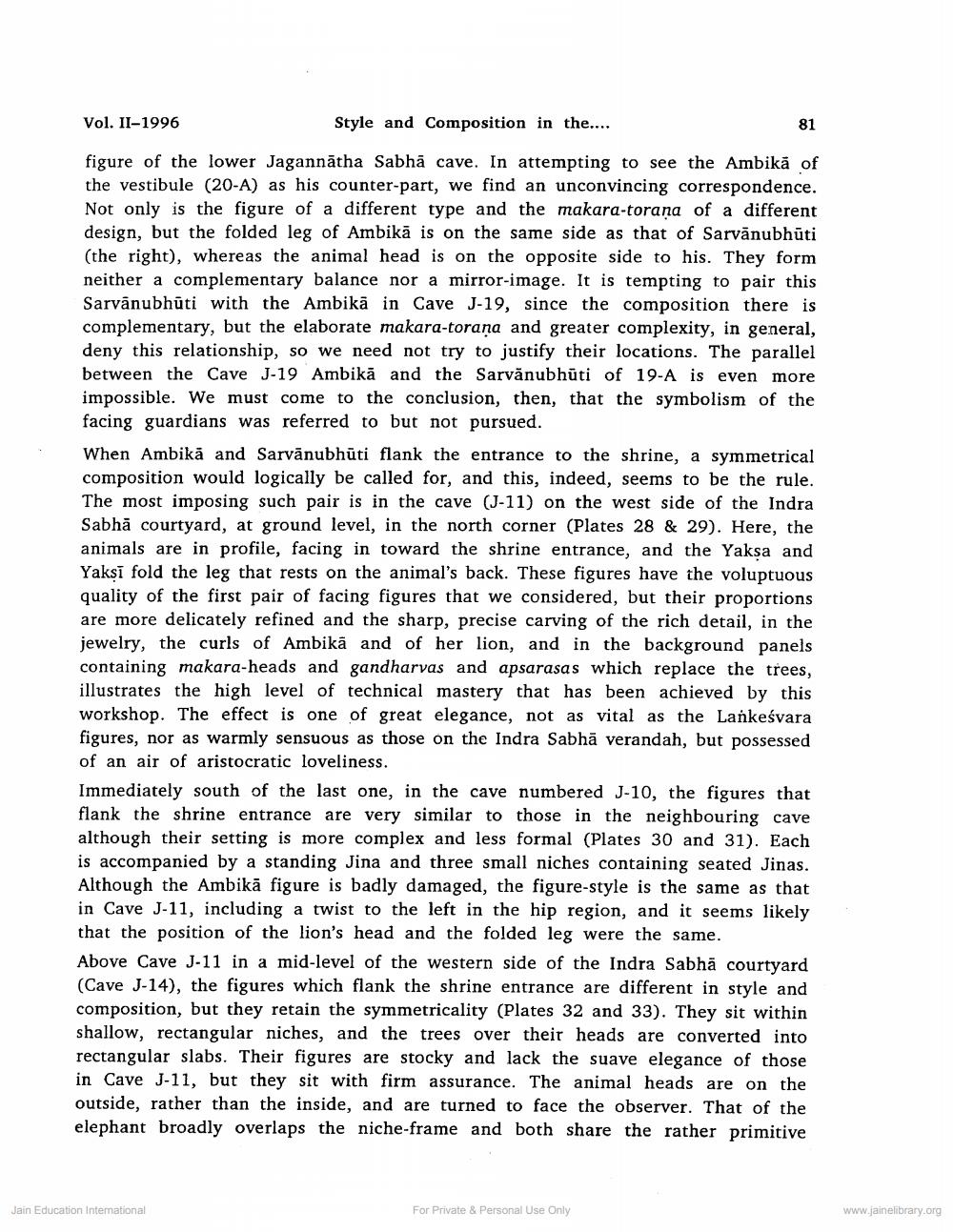________________
Vol. II-1996
Style and Composition in the....
figure of the lower Jagannatha Sabha cave. In attempting to see the Ambika of the vestibule (20-A) as his counter-part, we find an unconvincing correspondence. Not only is the figure of a different type and the makara-torana of a different design, but the folded leg of Ambika is on the same side as that of Sarvanubhuti (the right), whereas the animal head is on the opposite side to his. They form neither a complementary balance nor a mirror-image. It is tempting to pair this. Sarvânubhuti with the Ambika in Cave J-19, since the composition there is complementary, but the elaborate makara-toraṇa and greater complexity, in general, deny this relationship, so we need not try to justify their locations. The parallel between the Cave J-19 Ambika and the Sarvanubhuti of 19-A is even more impossible. We must come to the conclusion, then, that the symbolism of the facing guardians was referred to but not pursued.
When Ambika and Sarvānubhuti flank the entrance to the shrine, a symmetrical composition would logically be called for, and this, indeed, seems to be the rule. The most imposing such pair is in the cave (J-11) on the west side of the Indra Sabha courtyard, at ground level, in the north corner (Plates 28 & 29). Here, the animals are in profile, facing in toward the shrine entrance, and the Yakṣa and Yakṣi fold the leg that rests on the animal's back. These figures have the voluptuous quality of the first pair of facing figures that we considered, but their proportions are more delicately refined and the sharp, precise carving of the rich detail, in the jewelry, the curls of Ambika and of her lion, and in the background panels containing makara-heads and gandharvas and apsarasas which replace the trees, illustrates the high level of technical mastery that has been achieved by this workshop. The effect is one of great elegance, not as vital as the Lankesvara figures, nor as warmly sensuous as those on the Indra Sabha verandah, but possessed of an air of aristocratic loveliness.
81
Immediately south of the last one, in the cave numbered J-10, the figures that flank the shrine entrance are very similar to those in the neighbouring cave although their setting is more complex and less formal (Plates 30 and 31). Each is accompanied by a standing Jina and three small niches containing seated Jinas. Although the Ambika figure is badly damaged, the figure-style is the same as that in Cave J-11, including a twist to the left in the hip region, and it seems likely that the position of the lion's head and the folded leg were the same.
Above Cave J-11 in a mid-level of the western side of the Indra Sabha courtyard (Cave J-14), the figures which flank the shrine entrance are different in style and composition, but they retain the symmetricality (Plates 32 and 33). They sit within. shallow, rectangular niches, and the trees over their heads are converted into rectangular slabs. Their figures are stocky and lack the suave elegance of those in Cave J-11, but they sit with firm assurance. The animal heads are on the outside, rather than the inside, and are turned to face the observer. That of the elephant broadly overlaps the niche-frame and both share the rather primitive
Jain Education International
For Private & Personal Use Only
www.jainelibrary.org




